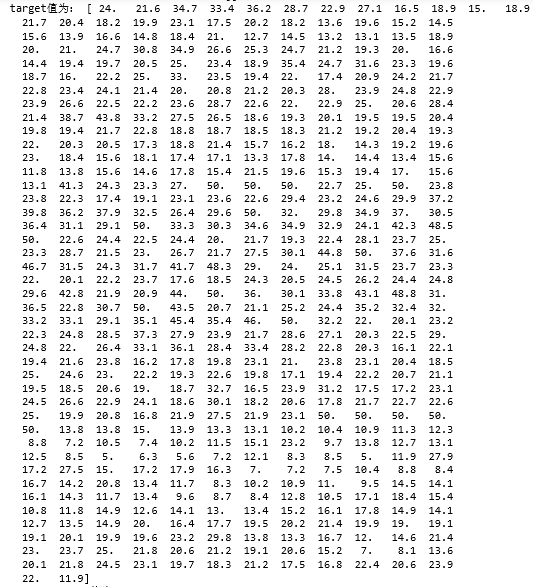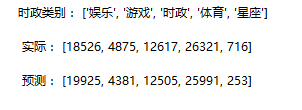一、Boston房价预测
1. 导入boston房价数据集
import numpy from sklearn.datasets import load_boston boston = load_boston() boston.keys()
#查看每一个key值# print('data值为:',boston.data) print('target值为:',boston.target) print('feature_names值为:',boston.feature_names)



2. 划分数据集
# 划分数据集
from sklearn.model_selection import train_test_split x_train, x_test, y_train, y_test = train_test_split(boston.data,boston.target,test_size=0.3) print(x_train.shape,y_train.shape)
3.线性回归模型:建立13个变量与房价之间的预测模型,并检测模型好坏。
from sklearn.linear_model import LinearRegression mlr = LinearRegression() mlr.fit(x_train,y_train) print('系数',mlr.coef_," 截距",mlr.intercept_) from sklearn.metrics import regression y_predict = mlr.predict(x_test) print('线性回归模型') print("预测的均方误差:",regression.mean_squared_error(y_test,y_predict)) print("预测的平均绝对误差:",regression.mean_absolute_error(y_test,y_predict)) print("模型的分数:",mlr.score(x_test,y_test))


4. 多项式回归模型:建立13个变量与房价之间的预测模型,并检测模型好坏。
from sklearn.preprocessing import PolynomialFeatures #多项式化 poly2 =PolynomialFeatures(degree=2) x_poly_train = poly2.fit_transform(x_train) x_poly_test = poly2.transform(x_test) #建立模型 mlrp=LinearRegression() mlrp.fit(x_poly_train,y_train) #预测 y_predict2 = mlrp.predict(x_poly_test) print("多项式回归模型") print("预测的均方误差:",regression.mean_squared_error(y_test,y_predict2)) print("预测平均绝对误差:",regression.mean_absolute_error(y_test,y_predict2)) print("模型的分数:",mlrp.score(x_poly_test,y_test))

5. 比较线性模型与非线性模型的性能,并说明原因。
答:
线性回归模型是一条直线,而多项式模型是一条平滑的曲线,相较之下,曲线更加贴合样本点的分布,并且误差比线性小,所以非线性模型的性能比线性模型的性能更好。
二、中文文本分类
(1) 导包;运用os、walk获取所需变量
import os import numpy as np import sys from datetime import datetime import gc path = 'C:\期末大作业\0369' #导入结巴库 import jieba #导入停用词 with open(r'C:\期末大作业\stopsCN.txt',encoding='utf-8') as f: stopwords = f.read().split(' ') def processing(tokens): tokens = "".join([char for char in tokens if char.isalpha()]) #去掉非字母汉字字符 tokens = [token for token in jieba.cut(tokens,cut_all=True) if len(token) >=2] #jieba分词 tokens = " ".join([token for token in tokens if token not in stopwords]) #去掉停用词 return tokens tokenList = [] targetList = [] #通过os、walk获取需要的变量 for root,dirs,files in os.walk(path): for f in files: filePath = os.path.join(root,f) with open(filePath,encoding='utf-8') as f: content = f.read() # 获取新闻类别标签,并处理该新闻 target = filePath.split('\')[-2] targetList.append(target) tokenList.append(processing(content))
运行结果:

(2) 划分训练集测试集并建立特征向量,为建立模型做准备
# 划分训练集测试集 from sklearn.feature_extraction.text import TfidfVectorizer from sklearn.model_selection import train_test_split from sklearn.naive_bayes import GaussianNB,MultinomialNB from sklearn.model_selection import cross_val_score from sklearn.metrics import classification_report x_train,x_test,y_train,y_test = train_test_split(tokenList,targetList,test_size=0.2,stratify=targetList) # 转化为特征向量,选择TfidfVectorizer的方式建立特征向量。不同新闻的词语使用会有差别。 vectorizer = TfidfVectorizer() X_train = vectorizer.fit_transform(x_train) X_test = vectorizer.transform(x_test) # 建立模型,这里用多项式朴素贝叶斯,因为样本特征的a分布大部分是多元离散值 mnb = MultinomialNB() module = mnb.fit(X_train, y_train) #进行预测 y_predict = module.predict(X_test) # 输出模型精确度 scores=cross_val_score(mnb,X_test,y_test,cv=5) print("Accuracy:%.3f"%scores.mean()) # 输出模型评估报告 print("classification_report: ",classification_report(y_predict,y_test))
运行结果:

(3)统计测试集和预测集的各类新闻个数
# 统计测试集和预测集的各类新闻个数 testCount = collections.Counter(y_test) predCount = collections.Counter(y_predict) print('实际:',testCount,' ', '预测', predCount)

(4)建表分类别
# 建立标签列表,实际结果列表,预测结果列表, nameList = list(testCount.keys()) testList = list(testCount.values()) predictList = list(predCount.values()) x = list(range(len(nameList))) print("时政类别:",nameList,' ',"实际:",testList,' ',"预测:",predictList)
